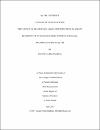Prevalence of Healthcare Associated Infections in Adults Recipients of Autologous Hematopoietic Stem Cell Transplantation in Qatar
| Advisor | Elhassan, Manar |
| Author | Nabih Daghfal, Joanne |
| Available date | 2017-06-19T10:36:04Z |
| Publication Date | 2017-06 |
| Abstract | Objective To analyze the prevalence and characteristics of Healthcare Associated Infections (HAI) in patients with hematologic malignancies who underwent Autologous Hematopoietic Stem Cell Transplantation (AHSCT) at the National Center for Cancer Care and Research (NCCCR) newly opened transplant unit in Qatar between October 2015 and October 2016 with global comparison of the bloodstream Infection (BSI) prevalence, one of the most prevalent complications after stem cell transplant. Methods The Center of Disease Control (CDC) definitions for laboratory-confirmed bloodstream infection (BSI), modified criteria for pneumonia and hospital-acquired infections were used. Statistical analysis was done using STATA version14. The entire healthcare associated infections (HAI) and other variables were described using means, proportions and 95% confidence intervals. Meta-Analysis of Observational Studies in Epidemiology guidelines was applied in conducting the meta-analysis. The systematic search in English was done in PubMed from 1970 (date of stem cell transplant kick off) to 2016. Inclusion was restricted to human hematology studies that included AHSCT. Statistical calculations allowing an accurate estimation of the prevalence were calculated using MetaXl version 5.3. The data extraction for both studies was done independently by two reviewers. Results Out of the sixteen patients, three developed infection leaving the overall infection rate to 18.75%. Chemotherapy induced gastroenteritis was documented in 68.7% of the cases, chemotherapy induced mucositis was documented in 43.7% of the cases. Most of the infections occurred during neutropenia (92.3%) and 69.2% of them during febrile neutropenia. No gastroenteritis was microbiologically confirmed, all were clinically documented infections. Bacterial infections accounted for 12.5% (2/16 cases) one upper respiratory tract infection and one urinary tract infection. Whereas viral infections, pneumonia and urinary tract infections were each 6.25% (1/16 cases respectively). There was no prevalence of bloodstream infection or central line associated bloodstream infection for any of the patients. As for the meta-analysis, the aggregated results were studied in the 10 included studies. Significant heterogeneity was noted among the studies (I2 = 99%; P = 0.0001), the pooled prevalence of blood stream infection among 55789 AHSCT patients from the ten studies was 6%, 95% CI: 0, 33. Conclusion This study provides original baseline data about the prevalence of HAI among AHSCT in NCCCR. These findings will be used for additional evaluation of the influence of infection prevention and control measures and therapeutic plans for these patients. They will also contribute to the enhancement of the quality of care in NCCCR, mainly in the hematopoietic stem cell transplant unit (HSCT) through the proper implementation of the infection control standards and proper implementation of antimicrobial stewardship program. |
| Language | en |
| Subject | Epidemiology [0766] - primary Healthcare Associated Infections (HAI) Chemotherapy Autologous Hematopoietic Stem Cell Transplantation (AHSCT) National Center for Cancer Care and Research (NCCCR) |
| Type | Master Thesis |
| Department | Public Health |
Files in this item
This item appears in the following Collection(s)
-
Public Health [35 items ]


